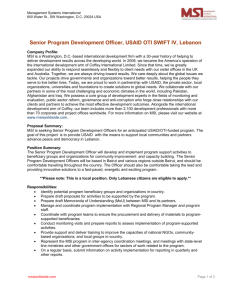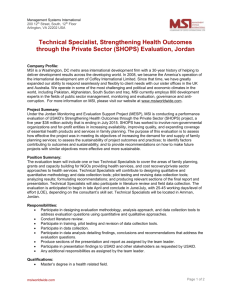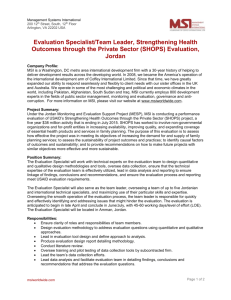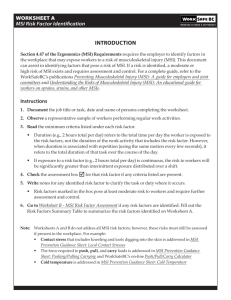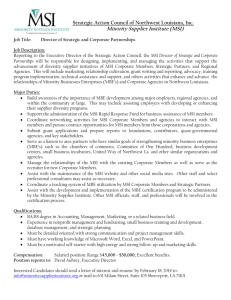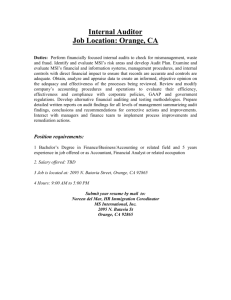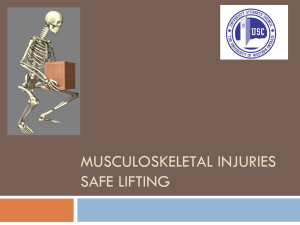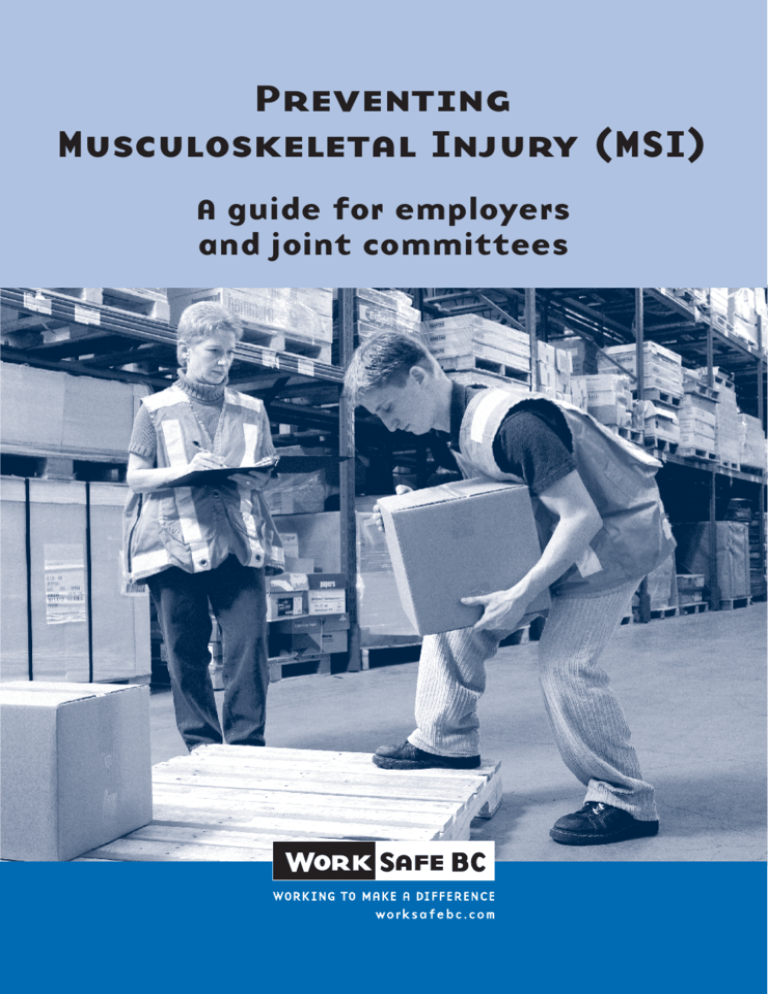
Preventing
Musculoskeletal Injury (MSI)
A guide for employers
and joint committees
About WorkSafeBC
WorkSafeBC (the Workers’ Compensation Board) is an independent
provincial statutory agency governed by a Board of Directors. It is
funded by insurance premiums paid by registered employers and by
investment returns. In administering the Workers Compensation Act,
WorkSafeBC remains separate and distinct from government; however,
it is accountable to the public through government in its role of
protecting and maintaining the overall well-being of the workers’
compensation system.
WorkSafeBC was born out of a compromise between B.C.’s workers
and employers in 1917 where workers gave up the right to sue their
employers or fellow workers for injuries on the job in return for a
no‑fault insurance program fully paid for by employers. WorkSafeBC
is committed to a safe and healthy workplace, and to providing
return‑to‑work rehabilitation and legislated compensation benefits to
workers injured as a result of their employment.
WorkSafeBC Prevention Information Line
The WorkSafeBC Prevention Information Line can answer your
questions about workplace health and safety, worker and employer
responsibilities, and reporting a workplace accident or incident.
The Prevention Information Line accepts anonymous calls.
Phone 604 276-3100 in the Lower Mainland, or call 1 888 621-7233
(621‑SAFE) toll-free in British Columbia.
To report after-hours and weekend accidents and emergencies,
call 604 273-7711 in the Lower Mainland, or call 1 866 922-4357
(WCB‑HELP) toll-free in British Columbia.
Preventing
Musculoskeletal Injury (MSI)
A guide for employers
and joint committees
WorkSafeBC Publications
Many publications are available on the WorkSafeBC web site. The
Occupational Health and Safety Regulation and associated policies
and guidelines, as well as excerpts and summaries of the Workers
Compensation Act, are also available on the web site: WorkSafeBC.com.
Some publications are also available for purchase in print:
604 232-9704
Phone: Toll-free phone: 1 866 319-9704
604 232-9703
Fax: 1 888 232-9714
Toll-free fax:
Online ordering: WorkSafeBC.com and click on Publications;
follow the links for ordering
© 2001, 2004, 2007, 2009 Workers’ Compensation Board of
British Columbia. All rights reserved. The Workers’ Compensation
Board of B.C. encourages the copying, reproduction, and distribution of
this document to promote health and safety in the workplace, provided
that the Workers’ Compensation Board of B.C. is acknowledged.
However, no part of this publication may be copied, reproduced, or
distributed for profit or other commercial enterprise, nor may any part
be incorporated into any other publication, without written permission
of the Workers’ Compensation Board of B.C.
2009 edition
Library and Archives Canada Cataloguing in Publication Data
Main entry under title:
Preventing musculoskeletal injury (MSI) : a guide for
employers and joint committees. -- 2001 ed. ISSN 1499-237X = Preventing musculoskeletal injury, MSI
1. Musculoskeletal system - Wounds and injuries Prevention. I. Workers’ Compensation Board of British
Columbia.
RD97.5.P73 2001
ii
613.6'2
C2001-960220-0
Contents
Introduction..................................................................................................... 1
Risk factors....................................................................................................... 2
Preventing MSI in the workplace................................................................. 2
Steps in the MSI prevention process............................................... 3
Step 1: Consultation........................................................................... 4
Step 2: Education................................................................................ 4
Step 3: Risk identification................................................................. 5
Step 4: Risk assessment..................................................................... 6
Step 5: Risk control............................................................................ 8
Step 6: Training................................................................................... 10
Step 7: Evaluation.............................................................................. 10
Investigating an MSI....................................................................................... 11
Getting assistance............................................................................................ 12
Common risk control options (chart)........................................................... 13
MSI investigation chart.................................................................................. 19
iii
Introduction
Some of the tasks we perform at work—such as lifting, reaching,
and repeating the same movements—can strain our bodies. In some
situations, these tasks can result in an injury to the muscles, tendons,
ligaments, nerves, blood vessels, and joints of the neck, shoulders, arms,
wrists, legs, and back. This type of injury is called a musculoskeletal
injury, or MSI.
MSI is a common type of workplace injury in all industries in
British Columbia. MSI claims associated with overexertion and
repetitive motion account for about one-third of claims accepted by
WorkSafeBC. In some industries, this proportion is much higher.
The Occupational Health and Safety Regulation lists specific
requirements to help employers prevent MSI. Based on the Regulation,
this educational booklet provides guidance to help employers,
joint health and safety committees, and worker health and safety
representatives implement an effective strategy to prevent MSI in the
workplace. It includes information that will help you to:
• Identify factors that place workers at risk for MSI
• Understand the steps in preventing MSI
• Understand how control measures can reduce the risk of MSI
• Investigate injuries and signs or symptoms of MSI
What is MSI?
The Occupational Health and Safety Regulation defines
musculoskeletal injury (MSI) as an injury or disorder of the
muscles, tendons, ligaments, joints, nerves, blood vessels or
related soft tissue including a sprain, strain and inflammation,
that may be caused or aggravated by work.
Introduction
1
Risk factors
The factors that contribute to the development of MSI are called risk
factors. A risk factor is something that may cause or contribute to an
injury. Two or more risk factors can be present at one time, increasing
the risk of injury.
The Occupational Health and Safety Regulation requires employers to
consider a number of factors when identifying and assessing the risk
of MSI. The physical risk factors for MSI are the demands of a task,
including force, repetition, work posture, and local contact stress.
For a description of these risk factors, along with illustrations and
examples, see the WorkSafeBC publication Understanding the Risks of
Musculoskeletal Injury (MSI): An Educational Guide for Workers on Sprains,
Strains, and Other MSIs. The publication also looks at factors that
influence the physical demands, such as the layout of the workplace
and the organization of work tasks. In addition, this booklet provides
information on the signs and symptoms of MSI and the potential health
effects of these injuries. The booklet is available in print or online
(see page 12).
The mere presence of MSI risk factors may not in itself result in an
injury. It depends on the extent of exposure—for example, how great
the force is and how long the worker is exposed to the risk. The extent
of exposure is further discussed in risk assessment (page 6) and risk
control (page 8).
Developing an MSI can also depend on individual characteristics that
vary from worker to worker (such as height, gender, and the body’s
ability to deal with the risk factors). In addition, activities outside the
workplace can result in exposure to the risk factors for MSI.
Preventing MSI in the workplace
Employers need to make sure that preventing MSI is a key part of their
company’s occupational health and safety program. The ergonomics
requirements listed in the Occupational Health and Safety Regulation
are intended to eliminate or minimize the risk of MSI to workers.
This booklet describes the process for preventing these injuries in the
workplace. This is not necessarily a linear process from beginning to
end. More than one step can take place at one time.
2
Preventing Musculoskeletal Injury (MSI)
Steps in the MSI prevention process
Step 1
Consultation
Consult with joint health and safety committee or worker health and safety
representative during each step in the MSI prevention process below.
▼
▼
Step 2
Education
Educate workers about risk factors, signs and symptoms of injury, and
potential health effects.
▼
▼
Step 3
Risk Identification
Identify jobs with a risk of MSI. Identify risk factors on those jobs.
▼
▼
Step 4
Risk Assessment
Assess identified risk factors to determine the degree of risk to workers.
Consult with affected workers and a representative sample of other
workers who perform the same tasks.
▼
▼
Step 5
Risk Control
Implement control measures, where required, to eliminate or minimize
the risk to workers.
▼
▼
Step 6
Training
Train workers in the use of control measures.
▼
▼
Step 7
Evaluation
Evaluate control measures to determine their effectiveness to eliminate
or minimize the risk of MSI. Where the risk has not been effectively
controlled, re-examine the task.
Preventing MSI in the workplace
3
Step 1: Consultation
Employers must consult with the joint committee or the worker health
and safety representative at every step of the MSI prevention process.
“To consult with” means to seek information or advice from the joint
committee or worker health and safety representative.
When doing a risk assessment (step 4), employers must also consult
with a sample of workers who carry out the tasks being assessed
and with workers who have experienced signs or symptoms of MSI.
Workers can also be consulted at other steps since they may know the
job best.
Step 2: Education
Employers must ensure that workers are educated about:
• Risk identification related to their work (factors that may put workers
at risk for MSI)
• The signs and symptoms of injury
• The potential health effects of MSI
The WorkSafeBC publication Understanding the Risks of Musculoskeletal
Injury (MSI): An Educational Guide for Workers on Sprains, Strains, and
Other MSIs can help with this education.
This publication is available on the WorkSafeBC web site (WorkSafeBC.com).
To order print copies, see page ii.
4
Preventing Musculoskeletal Injury (MSI)
Step 3: Risk identification
Employers are required to identify factors in the workplace that
may expose workers to a risk of MSI. This doesn’t mean that you
have to identify risk factors for every job at your workplace, just for
jobs in which there is reasonable expectation of a risk of MSI. Risk
identification should be conducted by people who understand both the
work process and the risk factors and who have some education and
training in the principles of risk assessment.
Since it is not practical to identify MSI risk factors associated with all
jobs at one time, a reasonable approach is to prepare a list of jobs in
order of decreasing risk and establish a plan in order of priority. To
determine which jobs are at a higher risk for MSI and should be given
priority, you might examine first aid records and claims history for MSI
and other relevant information.
The jobs of workers who have already had an MSI or have signs or
symptoms of MSI could have a higher risk of MSI. Therefore, priority
for risk identification should be given to jobs in the following situations:
• A worker has already had a work-related MSI claim
• A worker has been injured and reports to first aid with an MSI
• A worker has reported signs or symptoms of MSI
Risk identification should also take place before any problems or injuries
are reported so that risk factors can be eliminated or minimized and
injuries potentially prevented. To set priorities for preventive risk
identification, you might, for example, interview workers, take a survey,
or observe workers on the job. In addition, early risk identification can
help prevent injuries in the following situations:
• A worker or supervisor observes high exposures to risk factors in a
job—for example, during workplace inspections and observations of
current work methods.
• A new job is introduced or a process changes.
After identifying particular jobs that pose a higher risk of MSI to
workers, the employer needs to identify the MSI factors that contribute
to the risk for each of those jobs. There are several tools (such as
checklists and worksheets) available. Tools to help identify jobs or tasks
incorporating exposures that pose a risk of MSI can be obtained from
a WorkSafeBC officer (see list of local WorkSafeBC offices on the inside
Preventing MSI in the workplace
5
back cover). These tools help identify risk factors that require further
investigation to assess the risk to workers. Some of these tools take
duration and magnitude into account along with the risk factors to help
you establish priorities.
Other methods can be used to identify risk factors as long as they
include the risk factors listed in the Occupational Health and Safety
Regulation. The WorkSafeBC web site has links to various resources
(see page 12).
You can also contact your local WorkSafeBC office and talk to an officer
to get further guidance on risk identification for your workplace.
If the risk identification step reveals an obvious and effective risk
control that will eliminate or minimize the risk to workers, you
do not need to conduct a separate risk assessment (step 4) before
implementing controls (step 5). For example, if a receptionist twists
her neck to view the computer monitor (which has been placed to one
side), the employer may decide to alter the counter so there is room for
the monitor to be placed directly in front of the worker. This control
measure can be implemented without first assessing how long the
worker is in that posture or how severe it is.
Step 4: Risk assessment
Employers must assess the degree of risk (high, moderate, or low) to the
workers in those jobs or tasks where exposure to risk factors has been
identified. Risk assessment will help you decide which risk factors
pose a risk of injury to workers and are therefore important to control.
For example, you may have identified an awkward stooping posture
when a worker reaches to perform a task. During the risk assessment,
you may find out that the worker does this task only occasionally or for
a very short period of time during the day. There may be exposures to
other factors (such as high force and repetition) associated with other
tasks the worker performs for longer durations. In this example, force and
repetition pose a greater risk and need control measures more urgently.
During risk assessment, the employer must consult with workers who
have signs or symptoms of MSI and with a representative sample of
workers who perform the tasks being assessed. The sample should
include workers who represent a range of characteristics such as gender,
6
Preventing Musculoskeletal Injury (MSI)
age, and height. Some situations, however, may not require a specific risk
assessment. As stated in step 3, if the risk control is obvious and effective,
risk identification can lead directly to risk control. In such situations,
you should consult with workers at the risk identification stage.
Risk assessment should be performed by people who understand the
work process, the MSI risk factors, and the principles of risk assessment
and control. The basic principles of risk assessment involve looking at
the extent of exposure to assess how great the risk is. Extent of exposure
includes magnitude (how much), duration (how long), and frequency
(how often, how fast).
To take extent of exposure into account, consider questions such as
the following:
• What is the magnitude of the exposure? For example, how much
force is needed or how severe is the awkward posture?
• How long (total time) is the worker exposed to the risk? For example,
is the worker exposed to the risk for a full shift or for two hours?
• How frequently is the worker exposed to the risk? For example,
is the task repeated many times each shift or does it occur only
occasionally?
A risk assessment should also consider the following:
• What is the combined effect of all the identified risk factors? For
example, lifting heavy objects from the floor to a height above the
shoulders several times a minute poses a greater risk than lifting the
same objects between the knee and waist level infrequently.
• What body part is most likely to be affected? For example, when a
person is working overhead, the shoulders and neck may be affected.
If risk identification revealed exposure to risk factors that should
be assessed, it may be more efficient to conduct risk assessment
immediately following identification. In this way, the person doing the
identification can use information already gathered, ask questions, and
observe workers to assess whether the exposure is significant enough or
frequent enough to require risk controls.
Risk assessment tools are available from a WorkSafeBC officer. These
will help you assess the degree of risk (high, moderate, or low),
determine where controls are needed, and establish priorities for
implementing controls to prevent MSI.
Preventing MSI in the workplace
7
Step 5: Risk control
If risk controls are needed, the next step is to look at options. The
employer must eliminate the risk of MSI, or, if that is not practicable,
must minimize the risk. You should implement the risk controls selected
without undue delay. If there will be a delay in implementing permanent
controls, interim controls must be implemented without delay.
First consider engineering or administrative controls that eliminate
the risk to workers. If this is not practicable, introduce controls that
minimize the risk. Personal protective equipment can be used only if
engineering or administrative controls are not practicable.
• Engineering controls are the arrangement, design, or alteration of the
physical work environment, equipment, or materials. For example,
a mechanical lifting device is an engineering control that health care
workers can use to reduce the risk of MSI when moving patients.
• Administrative controls include the use and scheduling of resources
and staffing to improve how the work is organized and performed.
For example, limiting the hours a cashier spends at an express
checkout is an administrative control that can reduce the amount of
repetitive motion.
• Personal protective equipment and clothing may be used as a
control if other controls are not practicable, or in addition to other
controls. For example, workers may wear vibration-dampening
gloves while using a chainsaw or wear knee pads while working on
their knees to install flooring.
Some control measures will eliminate the exposure to the risk factor.
Where that is not possible, the control measures should result in the
extent of exposure being reduced in at least one of the following ways.
Reduced magnitude of exposure
Controls that reduce the magnitude of exposure involve, for example,
reducing the force required or making the work posture more comfortable:
• Use better-designed tools to reduce the effort. For example, use a
lighter tool or a suspended tool to reduce the force needed to grip the
tool (engineering control).
• Redesign the workstation to avoid excessive reaching or bending. For
example, change the height of the work surface to reduce the reaching
distance and an awkward shoulder posture (engineering control).
8
Preventing Musculoskeletal Injury (MSI)
• Modify the work practice. For example, use two people to lift a heavy
object instead of one person (administrative control).
Reduced duration of exposure
Reduced duration of exposure to the risk over the work shift involves
reducing the total time the worker is exposed to the risk:
• Use some mechanization to reduce the time spent during the day
doing physical tasks. For example, use a mechanical stacker for some
products during the shift (engineering control).
• Rotate jobs to reduce the time spent doing manual handling. For
example, rotate workers between manual stacking and forklift driving
(administrative control).
Reduced frequency of exposure
Reduced frequency of exposure to the risk involves reducing the
number of times the task is done in a period of time:
• Use partial mechanization to reduce repetition. For example, use
power tools for parts of the job and use hand tools only where the
power tools are not practical (engineering control).
• Combine other tasks with the job to reduce repetition. For example,
let a worker doing intense keyboarding tasks also handle nonkeyboarding tasks such as customer service (administrative control).
Improved pattern of exposure
The pattern of exposure can be improved if the time the worker is
exposed to the risk is divided into smaller blocks of time over the work
shift. This control can be used where it is not practical to reduce the
total duration of time on the task:
• Organize the work so that highly physically demanding tasks are
interspersed with less physically demanding tasks. For example,
rotate workers so that each worker does the physically demanding
task in two blocks of two hours instead of one block of four hours
(administrative control).
The table on pages 13–18, Common Risk Control Options, lists
examples of some controls to consider for the risk factors identified in
the Regulation.
Preventing MSI in the workplace
9
In addition to working through the MSI prevention process, the
employer must investigate certain situations involving MSI to
determine contributory causes. An investigation must lead to risk
controls that eliminate or minimize the risk to the injured worker and
prevent a recurrence of similar incidents. MSI investigations are further
discussed on page 11.
Step 6: Training
The employer must ensure that workers are trained to use the risk
control measures. For example, if you provide a worker with a
mechanical lifting device, the worker must be trained to use the
device properly. In addition, where safe work procedures have been
implemented to reduce the risk of MSI, workers must be trained and
supervised in those procedures. Workers must follow the safe work
procedures they have been trained to use and must use any engineering
controls and required personal protective equipment and clothing.
Step 7: Evaluation
Finally, the employer must evaluate the control measures to determine
how effective they are in eliminating or minimizing the risk of MSI.
Some ways to evaluate the controls are:
• Interviewing workers
• Looking for decreases in the number and severity of signs and
symptoms of MSI
• Observing a reduction in the number of risk factors or in the severity
of risk factors
• Using a checklist or other tool to compare the exposure to risk factors
before and after controls are implemented
If the risk has not been effectively controlled or if new risks have been
created, re-examine the task and reconsider which controls may be
needed. Additionally, the employer needs to evaluate the overall MSI
prevention program at least once a year to make sure it continues to
meet the objective of eliminating or minimizing the risks to workers.
10
Preventing Musculoskeletal Injury (MSI)
Investigating an MSI
The employer is required to conduct an investigation into the following
situations associated with MSI:
• Where a worker has a work-related MSI requiring medical treatment
• Where an incident had the potential to result in a serious MSI
Unsafe or harmful conditions must also be reported and investigated.
For example, if a worker reports persistent signs or symptoms of MSI
(such as swelling or tingling), there may be an unsafe work situation
that could lead to a serious MSI. The unsafe condition must be
investigated.
The focus of these MSI investigations is to:
• Identify risk factors that likely contributed to the MSI or to the unsafe
condition that may result in MSI
• Implement controls to prevent the recurrence of similar injuries or to
correct the unsafe condition
To assist with the investigation process, a chart is provided on pages
19–23. This chart is useful in correlating which risk factors might have
contributed to the injury of the specific body part. The chart can help
you focus on the risk factors that may need immediate attention. You
will then need to assess each applicable risk factor and eliminate or
minimize its impact on the worker.
In the MSI Investigation Chart, each risk factor gives examples of
movements or activities. Some of the examples involve more than one
risk factor (such as exerting force with a bent wrist). The right side of
the chart shows the following four areas of the body:
• Neck, shoulders, upper back
• Lower back
• Elbows, forearms, hands
• Hips, knees, feet
First, choose the area of the body you are focusing on. Then look at the
corresponding risk factors on the left side of the chart. For example, if
you are investigating tasks performed by a worker who is experiencing
lower back pain, you should look under the lower back heading. Where
there is a circle, investigate the corresponding risk factors and look at the
examples of movements and activities. The investigation should result
in control measures that eliminate or minimize exposures to these factors.
Investigating an MSI
11
To use this chart, the person identifying risk factors needs to observe
workers, one task at a time. Only some factors from the chart will apply
to each task.
Getting assistance
The WorkSafeBC web site (WorkSafeBC.com) has a Safety at Work
centre with ergonomics as a topic. Visit the site for more information on
MSI and for links to other ergonomics sites.
The following WorkSafeBC publications include information about MSI
topics. These publications are all available on the WorkSafeBC web site.
Some are available in print (see page ii for ordering information).
• Back Talk: An Owner’s Manual for Backs
• Constructive Ideas: Innovative Ideas to Reduce Soft Tissue Injuries in the
Construction Industry
• Ergonomic Commentary 1: Back Belts
• Ergonomic Commentary 2: Wrist Braces
• Ergonomic Commentary 3: PC Mouse
• How to Make Your Computer Workstation Fit You
• MSI Prevention Bulletins
• Preventing Tree Planting Injuries
• Understanding the Risks of Musculoskeletal Injury (MSI): An Educational
Guide for Workers on Sprains, Strains, and Other MSIs
The WorkSafe™ Education Network offers a course on preventing
and investigating MSI; it is offered in various school districts and
community colleges. For information on this course, call the campus in
your area or call WorkSafeBC at 604 276-3100 in the Lower Mainland or
toll-free in B.C. at 1 888 621-SAFE (7233).
If you have questions about health and safety requirements, you can
call the WorkSafeBC Prevention Information Line at 604 276-3100 in the
Lower Mainland or toll-free in B.C. at 1 888 621-SAFE (7233).
A WorkSafeBC officer can give further guidance on how to prevent MSI
at your workplace and can provide some tools such as checklists for risk
identification and assessment. See the list of local WorkSafeBC offices
on the inside back cover.
12
Preventing Musculoskeletal Injury (MSI)
Common risk control options
This table does not include all possible options for risk control. It is
a starting point for the selection of appropriate risk controls. Priority
should be given to controls that do not rely primarily on changes
in worker behaviour to reduce the risk of MSI. First try to eliminate
the risk, but if that is not practicable, minimize the risk. Engineering
or administrative controls must be used before personal protective
equipment where practicable.
Risk factor
Force: Lift,
lower, or
carry
Common risk control options
Eliminate the need to manually lift, lower, or carry objects by
using engineering controls such as hoists, pallet jacks, carts,
and conveyors. If that is not practicable, consider options
such as the following to minimize risk:
•Minimize the distance of the load from the worker (e.g.,
use turntables; move the worker closer to the object; don’t
place obstructions close to the object).
•Minimize the vertical distance over which the load is lifted
or lowered (e.g., use pallet jacks; limit shelf height).
•Avoid tasks below knuckle height (e.g., use scissor lifts,
pallet jacks).
•Avoid tasks above shoulder height (e.g., limit shelf heights;
improve storage practice; raise the worker).
•Avoid stooped or twisted positions (e.g., provide
unrestricted work space; arrange the workstation to
minimize twisting when the worker picks up or puts down
a load).
•Minimize the size of the load (e.g., order loads in smaller
containers; have worker take two trips rather than one).
•Minimize carrying distance (e.g., have a well-designed
work flow).
•Avoid handling heavy or unbalanced objects while sitting
down (e.g., stand so that stronger muscles are used to
perform physically demanding tasks; avoid handling more
than 4.5 kilograms/10 pounds while sitting down).
•Improve the grip on the load (e.g., provide good handles
on containers; add clamps or other devices to improve grip).
•Change the design of the task (e.g., from a lifting task to a
lowering task; from a lifting, lowering, or carrying task to a
pushing or pulling task).
•Use pause periods or job enhancement to permit muscles to
recover from applying force for prolonged periods.
Common risk control options
13
Risk factor
Common risk control options
Force:
Push or pull
Eliminate the need to manually push or pull objects by using
engineering controls such as conveyors, hoists, and gravityfed systems. If that is not practicable, consider options such
as the following to minimize risks:
•Use carts that are well designed and appropriate to
the task:
– Handle can be grasped between waist and shoulder
height (e.g., vertical handles that can accommodate
workers of different heights).
– Load can be secured on the cart if necessary (e.g., belts or
clamps provided).
– The size, number, and type of wheels are appropriate for
the floor surface and weight carried.
– Moving parts are maintained (preventive maintenance).
– The worker has good visibility when pushing the cart.
•Use carts in an unrestricted area:
– The worker is able to push and is not forced to pull
the cart.
– The worker can assume a comfortable position to initiate
and maintain movement of the load.
– The worker is not forced to assume awkward postures
because of restricted work space or poor visibility.
•Use carts in areas with proper flooring or surface:
– The floor is clean (e.g., no debris or clutter on floor).
– The floor does not slope and is not slippery.
– There is no thick, plush, or shag carpet.
– The surface is level (e.g., minimize surface height
changes in areas such as the entrance to elevators; fill
potholes and cracks in surface).
•Reduce the load (e.g., make two trips).
•Reduce the total time spent pushing or pulling, or break
the total time into smaller blocks of time doing that task.
14
Preventing Musculoskeletal Injury (MSI)
Risk factor
Force: Grip
Common risk control options
Eliminate the need to manually grasp or handle objects by
using engineering controls such as clamps or automated
tools. If that is not practicable, consider options such as the
following to minimize risk:
•Maintain a straight wrist (neutral position) through:
– Improved design of handles (e.g., bent instead of straight
handles)
– Improved design of workstation (e.g., parts containers
that are tilted instead of flat; use of in-line tools)
– Improved work practice (e.g., conscious effort to keep
wrist straight)
•Use power grip to grasp objects through:
– Improved design of objects or handles on tools (e.g.,
using boxes with cut-outs to permit power grip; adding
handles to objects)
– Improved layout of workstation (e.g., objects positioned
to permit easy access to handles)
– Improved work practice (e.g., conscious effort to avoid
pinch grip)
•Avoid strong or hard grasping of vibrating tools through:
– Improved design of tools (e.g., tools with built-in
vibration-dampening sleeve)
– Improved work practice (conscious effort not to grasp
too hard)
– Use of personal protective equipment (e.g., well-fitting
vibration-dampening gloves to reduce grip force)
•Avoid handling objects with cold surface temperature
through:
– Improved work practice (e.g., at the end of the day, store
the next day’s supplies inside instead of keeping them
outside where they will be cold by morning)
– Improved work procedure (e.g., avoid skin contact by
using tools or utensils for grasping; use warm water
periodically to warm hands)
– Use of suitable gloves
•Improve grip while handling slippery objects by using
friction-enhanced, well-fitting gloves or gloves with
fingers removed.
•Reduce the total time spent manually gripping objects,
or break the total time into smaller blocks of time doing
that task.
Common risk control options
15
Risk factor
Common risk control options
Repetition
Eliminate highly repetitious tasks by using engineering
controls such as mechanization (e.g., power tools) or
automation. If that is not practicable, consider options such
as the following to minimize risk:
•Combine or eliminate some parts of work to reduce the
pace of repetition.
•Incorporate flexibility over pace (e.g., allow the worker to
take rest breaks and micro-pauses or to control the speed of
the conveyor).
•Use good work techniques (e.g., avoid unnecessary
repetitions as with multiple scanning of grocery items or
multiple turning of lumber for grading).
•Reduce the duration of exposure to repetition (e.g., offer
job rotation or job enhancement).
Work
posture
Eliminate awkward postures by using engineering controls
such as adjusting work heights, minimizing reaching
distances, changing orientation of work, changing layout of
workstation, using adjustable or angled tools and equipment,
and using turntables, conveyors, tilted surfaces, or springloaded surfaces. The objective is to enable the worker to work
in a comfortable posture. Every posture requires periodic
changes and movement or it becomes static. If elimination of
awkward postures is not possible, consider options such as
the following to minimize risk:
•Minimize awkward postures of the trunk:
– Minimize forward bending by increasing the work height
or moving objects closer (e.g., use turntables; improve
layout of workspace).
– Minimize side bending by reducing the reach distance or
moving objects to the front of the worker (e.g., improve
layout of work space; move closer to the objects).
– Minimize twisting by reducing reach distance or moving
objects to the front of the worker (e.g., improve layout of
work space; move closer to the objects).
16
Preventing Musculoskeletal Injury (MSI)
Risk factor
Work
posture
(continued)
Common risk control options
•Minimize awkward postures of the shoulder:
– Minimize reaching forward by reducing the reach
distance or lowering the work height.
– Minimize reaching sideways by reducing the reach
distance, lowering the work height, or moving objects to
the front of the body.
– Minimize reaching behind by moving objects to the front
of the worker.
– Minimize reaching across the body by moving closer
to the objects or transferring objects from one hand
to another.
•Minimize awkward postures of the wrist by selecting the required tools with appropriate handles (e.g., angled
handles).
•Minimize forearm rotation by using power tools or
mechanical turners.
•Minimize squatting and kneeling by raising the work.
•Minimize static postures:
– Provide footrests to allow the worker to transfer weight
from one foot to another.
– Provide opportunities for the worker to move about
periodically.
•Minimize awkward postures while sitting by providing
an appropriate chair that is adjusted to give good back
support, maintain a comfortable posture, and minimize
contact stress.
•Provide tilted sit-stand stool to take weight off the worker’s
feet and legs while allowing mobility.
Local contact Eliminate or minimize exposure to local contact stress:
stress
•Change or modify equipment (e.g., use a long-handled
screwdriver to prevent the butt from digging into the palm).
•Change or modify work area to prevent sharp edges from
digging into the skin (e.g., pad sharp or metal edges).
•Use personal protective equipment (e.g., use knee pads
while kneeling; use padded gloves when lifting heavy
objects by narrow plastic strapping).
•Improve or change work practice:
– Avoid resting or leaning against sharp edges.
– Avoid using a body part (e.g., hand or knee) as a hammer.
Common risk control options
17
Risk factor
Common risk control options
Environment Eliminate or minimize exposure to whole-body vibration:
•Avoid sitting or standing for prolonged periods on a
vibrating surface if practicable (e.g., catwalks on vibrating
machinery).
•Isolate the source of vibration from the rest of the work
space to prevent transmission of vibration to the sitting
or standing area (e.g., isolation of truck cabs from diesel
engine vibration).
•Keep equipment well maintained to reduce vibration.
•Reduce total exposure to vibration by breaking up driving
tasks or incorporating job rotation.
•Keep road surfaces well maintained where possible.
Keep the body warm at a comfortable temperature:
•Use local source heating.
•Wear warm clothing.
•Take rest breaks in warm areas.
Ensure that lighting is proper for the task being performed
and glare is avoided so that the worker does not assume
awkward postures to compensate for glare, brightness, or
inadequate lighting.
Work
organization
Ensure that repetitive or demanding tasks incorporate
opportunities for rest or recovery (e.g., allow brief pauses
to relax muscles; change work tasks; change postures or
techniques).
Incorporate task variability so that the worker does not have
to perform similar repetitious tasks throughout the full shift.
Provide the worker with the opportunity to vary work tasks
by rotating jobs or increasing the scope of the job.
Ensure that work demands and work pace are appropriate.
18
Preventing Musculoskeletal Injury (MSI)
MSI investigation chart
This chart can be used to correlate risk factors with specific body parts
when investigating an injury or signs and symptoms of MSI. For each
risk factor, use or adapt the examples of activities or movements that
could place a worker at risk.
Risk factor
Neck,
Elbows,
shoulders, forearms,
upper back hands
Lower
back
Hips,
knees,
feet
The risk factor applies to the
body part marked with a ●
FORCE: Lift, lower, or carry
Worker lifts, lowers, or carries objects:
•That are alive (people, animals)
•That are large or odd-shaped
•That are heavy or unbalanced or that
have a shifting centre of gravity
•That are difficult to grasp or hold onto
•Using awkward postures (e.g., stooped,
long reach)
•Over long distances
•From a sitting position
•Frequently or repeatedly
●
●
●
●
●
●
●
●
FORCE: Push or pull
Worker pushes and/or pulls objects:
•That are unstable
•With a handle height above the shoulder
or below the waist
•Over long distances
•By sliding the load
•Over uneven, sloping, or slippery
surfaces
•Within restricted space
•Using poorly maintained or designed
equipment
•Using awkward postures
•Using visible effort
MSI investigation chart
19
Neck,
Elbows,
shoulders, forearms,
upper back hands
Risk factor
FORCE: Grip
Worker uses grip force to grasp or
handle objects:
•With a bent wrist
•With a wide grip span
•With a firm grip
•Wearing poorly fitting gloves
•That vibrate
•That have a cold surface temperature
•That have a slippery surface
•Using a pinch grip
Lower
back
Hips,
knees,
feet
The risk factor applies to the
body part marked with a ●
●
●
Pinch grip
REPETITION
Worker repeats similar motions with the
same body part.
●
●
●
●
WORK POSTURE
The trunk of the body is in an awkward
posture.
20
●
Bending trunk forward
Bending trunk to side
Twisting trunk
Bending trunk backward
Preventing Musculoskeletal Injury (MSI)
Neck,
Elbows,
shoulders, forearms,
upper back hands
Risk factor
WORK POSTURE (continued)
Either shoulder is in an awkward posture:
•When worker uses excessive reach, such
as in front or to the side
•When worker reaches above the shoulder
•When worker reaches across or behind
the body
Bending neck to side
●
Moving shoulder out
●
Bending neck backward
Worker bends the wrist.
Bending wrist forward
Hips,
knees,
feet
The risk factor applies to the
body part marked with a ●
Moving shoulder forward
Worker bends or twists the neck.
Lower
back
●
Bending wrist backward
Bending wrist to outside
MSI investigation chart
21
Neck,
Elbows,
shoulders, forearms,
upper back hands
Risk factor
WORK POSTURE (continued)
Worker twists the forearm.
Lower
back
Hips,
knees,
feet
The risk factor applies to the
body part marked with a ●
●
Forearm rotation
Worker squats or kneels.
Squat position
●
Kneeling
Worker sits:
•Using a poor posture
•For long periods
•Resulting in local contact stress
•With no back support
•Using a poorly designed or poorly
adjusted chair
●
Worker stands:
•On a very hard surface (e.g., concrete)
•For long periods of time
•With no footrest
•Using foot pedals continuously
●
22
Preventing Musculoskeletal Injury (MSI)
●
Risk factor
LOCAL CONTACT STRESS
Worker contacts a hard or sharp object
or surface:
•With a tool or object digging into hand
or arm
•With a body part resting against a
sharp edge
•When kneeling
•When the hand or body strikes an
object, such as using a knee or hand as
a hammer
Using hand as a hammer
Neck,
Elbows,
shoulders, forearms,
upper back hands
Lower
back
Hips,
knees,
feet
The risk factor applies to the
body part marked with a ●
●
●
●
Using knee as a hammer
THE ENVIRONMENT
Worker sits or stands on a vibrating
surface.
●
Parts of the body are cold while
performing tasks.
●
Lighting is inappropriate for the tasks
being performed, such as:
•Too much glare
•Too bright
•Too dark
●
●
●
●
●
●
ORGANIZATION OF WORK
Worker uses the same muscles without
opportunities for recovery or rest.
●
●
●
●
Worker is unable to keep up with the pace
or demands of the work tasks.
●
●
●
●
MSI investigation chart
23
Notes
WorkSafeBC Offices
Visit our web site at WorkSafeBC.com.
Abbotsford
North Vancouver
2774 Trethewey Street V2T 3R1
Phone 604 276-3100
1 800 292-2219
Fax 604 556-2077
400 – 224 Esplanade Ave. W. V7M 1A4
Phone 604 276-3100
1 888 875-6999
Fax 604 232-1558
Burnaby
Prince George
450 – 6450 Roberts Street V5G 4E1
Phone 604 276-3100
1 888 621-7233
Fax 604 232-5950
1066 Vancouver Street V2L 5M4
Phone 250 561-3700
1 800 663-6623
Fax 250 561-3710
Coquitlam
Surrey
104 – 3020 Lincoln Avenue V3B 6B4
Phone 604 276-3100
1 888 967-5377
Fax 604 232-1946
100 – 5500 152 Street V3S 5J9
Phone 604 276-3100
1 888 621-7233
Fax 604 232-7077
Courtenay
Terrace
801 30th Street V9N 8G6
Phone 250 334-8765
1 800 663-7921
Fax 250 334-8757
4450 Lakelse Avenue V8G 1P2
Phone 250 615-6605
1 800 663-3871
Fax 250 615-6633
Kamloops
Victoria
321 Battle Street V2C 6P1
Phone 250 371-6003
1 800 663-3935
Fax 250 371-6031
4514 Chatterton Way V8X 5H2
Phone 250 881-3418
1 800 663-7593
Fax 250 881-3482
Kelowna
Head Office / Richmond
110 – 2045 Enterprise Way V1Y 9T5
Phone 250 717-4313
1 888 922-4466
Fax 250 717-4380
Prevention Information Line:
Phone 604 276-3100
1 888 621-7233 (621-SAFE)
Administration:
6951 Westminster Highway
Phone 604 273-2266
Mailing Address:
PO Box 5350 Stn Terminal
Vancouver BC V6B 5L5
Nanaimo
4980 Wills Road V9T 6C6
Phone 250 751-8040
1 800 663-7382
Fax 250 751-8046
Nelson
524 Kootenay Street V1L 6B4
Phone 250 352-2824
1 800 663-4962
Fax 250 352-1816
After Hours
Health & Safety Emergency
604 273-7711
1 866 922-4357 (WCB-HELP)
R06/06
R09/09
Printed in Canada
BK77

